Old Challenges Emerge for Modern C2
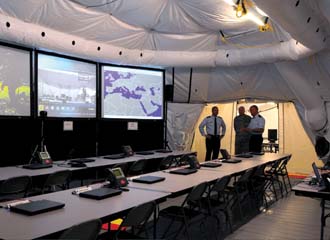 | |
The command and control forward (C2-Forward) concept displayed at Ramstein Air Base, Germany, reflects the needs of a joint air component commander operating in a multiservice environment. The individual services must design their C2 systems around their own mission needs, but they also must allow for interoperability. |
Future command and control systems may have agility serving as the foundation for their success. Changes in missions, enabling technologies and threats are altering the landscape for command and control capabilities at all levels of military operations.
The emergence of cyber as a warfighting domain has changed the equation for providing reliable command and control (C2). Ubiquitous networking of a mobile force may offer more command capabilities, but it also opens up opportunities for cybermarauders to ply their trade. And, the growing possibility that terrorists might deploy weapons of mass destruction is increasing the importance of long-dormant nuclear C2.
John G. Grimes, former assistant secretary of defense for networks and information integration (ASD NII) and department chief information officer (CIO), believes that the military needs a very agile C2 capability to deal with today’s network-centric environment. That need for agility reflects both the challenges to the network and the missions it must fulfill.
“A C2 system is dictated by the mission it has to support,” Grimes declares. “It can be a global mission, or it can be a very local mission. And, the operational side of it is dictated by the person responsible for executing the mission.”
C2 is an operational function, Grimes offers, and an operational commander must know how to use its tools and technology. First, however, that commander must understand the doctrine and how it affects a unit—whether that unit is a single unmanned aerial vehicle or a nuclear weapon platform.
The most critical elements of C2 are situational awareness and decision support aids along with battle damage assessment, which Grimes says is often lost in the C2 decision process but is important for C2 efficiency. Operating within an enemy’s decision cycle is critical for decision making, he states, and situational awareness is vital.
The individual services have performed substantial work in C2 because each has its own C2 capability for the types of missions it must face. And, these capabilities must reflect each service’s mission needs. “Anything you do in C2 has to be based on a concept of operation,” Grimes emphasizes. He notes that the U.S. Army established an effective logistics system to support the wars in Afghanistan and Iraq. It was a relatively simple means of C2 that supported the active fight.
A community of interest effort that began in the department’s CIO office about six years ago has been striving to ensure that these diverse C2 systems interoperate, Grimes relates. That interoperability, along with that affecting NATO, remains a concern, he allows.
Another concern is cyber. As a new warfighting domain, cyber will require a comprehensive real-time C2 system that also will rely on computer-to-computer tools—particularly for engaging in offensive cyberwarfare, Grimes observes. When a network detects an attack, its leaders need the capability to react immediately even before the nature of the attacker is known.
“Computer-to-computer tools have become more critical because the dynamics of warfighting, with all the information available, make it important that information is there quicker and is accurate for decision making,” Grimes declares. The speed inherent in direct computer linkage enhances the decision process, he adds.
One traditional C2 area that recently has been lacking in emphasis is nuclear C2, Grimes states. Even deep into the post-Cold-War era, nuclear C2 remains an important element. New threats have emerged in the nuclear arena from countries such as North Korea and potentially Iran, and Russia has indicated that it will modernize its nuclear force and strategic defenses. “It’s critical that our C2 decision processes are in place and continuously exercised to make sure we are ready to go,” he says.
“More than that, they [nuclear C2 assets] operate over a net-centric network that must be hardened against cyber and nuclear effects, and they must be able to operate through a nuclear exchange just like they used to be during the Cold War,” he continues. “I do not see that as being a priority today, and a lot of that comes back to the budget situation.”
Grimes allows that five years ago most experts would have believed that U.S. nuclear weapons never would be used again. Now, however, the new and different threats have changed that attitude. Smaller nuclear weapons in the hands of terrorists could be delivered to an urban target without the use of a missile or aircraft.
Even Pakistan cannot be overlooked as a nuclear threat, Grimes offers. Al- Qaida and Pakistan have had discussions over the terrorist group’s presence in that country, and Pakistan cannot be ruled out as a potential source of nuclear proliferation.
 |
A National Guardsman uses Blue Force Tracker to communicate with a tactical operations center during joint exercise to simulate responses to a nuclear attack on the United States. Long-dormant nuclear C2 capabilities may need to be upgraded to deal with the changed nature of the nuclear threat. |
Another major concern that has resurfaced is electromagnetic pulse, or EMP. This threat may come not so much from a nuclear detonation but instead from a non-nuclear EMP pulse weapon. U.S. military laboratories have been working on these types of weapons both for offensive use and for defensive purposes. This type of “electrical fire” weapon employing new technologies would be a serious threat to electrical infrastructures, Grimes points out.
Again, being able to maintain effective C2 during this type of attack would require an agile C2 capability, Grimes emphasizes. He suggests that nuclear C2 is not at its peak in readiness because it has not been emphasized the way it was during the Cold War.
A related issue is network-centric operation and the protection of data in the infrastructure, Grimes allows. “You can have all the information in the world, but if it is not accurate and you can’t get it to the commander to make a decision in real time, then it’s not worth a darn to you,” he declares.
“The network itself is the potential problem,” Grimes warns. “Today, I would resist putting everything for nuclear C2 on the Internet—IP—for controlling forces. I resisted that when I was in office [ASD NII], and we kept the red switch program of circuit switches so that we had alternative ways of operating.
“Denial of service is critical,” he says. “Either one of those [Internet or red switch] can have a denial-of- service attack if you take down the physical layer of the transmission media, both terrestrial and space.”
Grimes continues that a majority of the C2 network is provided by commercial carriers, and the military has arrangements with them to protect their networks. The only segment that is not covered commercially is provided instead by military satellites. A host of new military satellites are scheduled to increase the networking capacity, but they likely will supplement rather than supplant the commercial links.
“With commercial vendors, you have to have redundancy so that you get immediate restored service,” he says.
To achieve the agile C2 capability that Grimes believes is necessary will require two accomplishments, he says. Achieving the first focuses on how operators organize to fight, which stems from their basic operational concept. The other realm involves technology to support operator needs. “Many C2 systems and capabilities operate in a harsh environment. It’s not a benign and clean environment, so any technologies used to support C2 must take this into account,” he emphasizes. Desert combat is different from operations in cold regions, for example, and technologists must take that into account.
Experts also must be sensitive to enemy capabilities to jam or spoof C2 systems, particularly with cyberthreats, Grimes states. In addition to cyber attacks, spoofing can be achieved through conventional electronic warfare measures. All these threats must be taken into consideration in C2 design, with function playing a key role. “You wouldn’t want to invest a lot of money in tactical systems that are hardened for EMP for the soldier; that would be unnecessary,” he points out. Yet, networks must be secure and hardened to provide a degree of positive control for any decision, especially at the strategic level.
Grimes believes that the military is taking the right approach to building effective C2, but he has some concerns. The increase in cyber exploitation makes a big target for potential and existing adversaries.
“When a major task force is stood up, it must interoperate with the combatant command with which it is deployed,” he points out. “When units—Army, Navy or Air Force—are brought into theater, they must interoperate with the task force.
“All these are subject to cyber attacks and spoofing, and one must ensure that the networks supporting those missions are there so the task force can operate,” he declares.
Another problem is outsourcing the production of U.S. military equipment components. Some of these foreign-made electronics could have unwanted embedded hardware or software that would permit an enemy to exercise its own command and control over that particular system.
The Defense Department and the services are addressing many of these issues, but they must bring together the operators—the J-3s, the G-3s, the N-3s and the A-3s, Grimes says. These people must be the drivers for C2 for their various missions.
“There has to be new thinking because there are new tools out there,” Grimes states. He cites the Web, new satellites and new technology-based capabilities such as smartphones. One C2 growth area is the use of video, he observes, noting that many of the sensor platforms and pods in use today employ it. “All of that [technology] is coming fast, and it’s being used in certain special operations areas already. It will become pervasive in C2 as we go forward,” he warrants.
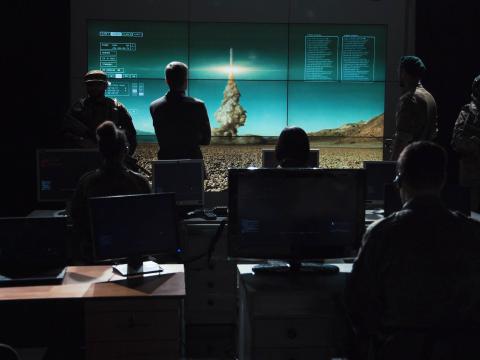
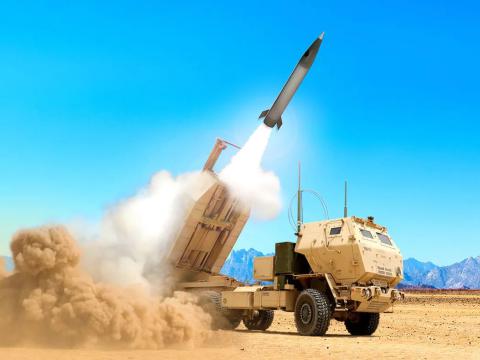
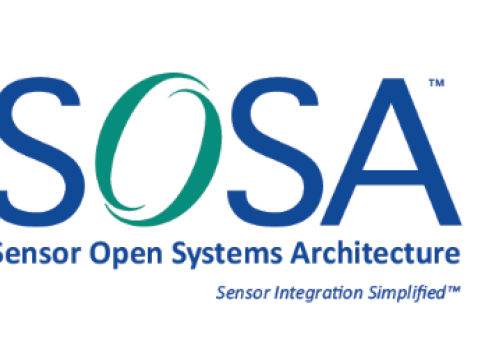
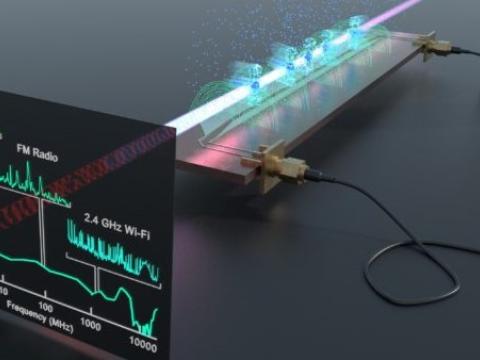
Comment
Readers may be interested in
Comments